A complete guide to making Easy Sautéed Vegetables for a tasty, nourishing side dish to any meal! This is my daily dose of veggies that I make 9 days out of 10. Whip up a big batch and eat it throughout the day or week!
You’re about to learn exactly how many vegetables I eat every day.
I’ve shown my meals on my Instagram stories many times, and if you follow me, you may have noticed a trend.
There’s always a metric truck ton of vegetables in my bowl.
Not only does variety in plants and animals promote a diverse, beneficial gut microbiome, but it ensures you’re getting the micronutrients you need to stay energized with great focused and balanced hormones.
While I’m not dogmatic about other people’s diets, I find I do well on a tremendous amount of cooked fiber (I don’t do raw vegetables often).
The GI runs the way it should, my energy level stays high, my blood sugar is in balance…all the things I strive for in optimizing my health.
But let’s get straight to this easy sautéed vegetables recipe. It’s one of those side dishes you can put on repeat over and over and no one gets tired of it.
In fact, when friends come over for dinner, they’re always obsessed with these sautéed veggies.
People think I put some sort of secret magic into making vegetables taste good, but really the only trick is in the technique.
Vegetables will taste great as long as they’re cooked properly! Even vegetable naysayers and picky eaters will eat them, I do solemnly swear.
So let’s get started.
What Type of Vegetables To Use For Sautéed Vegetables:
When it comes to selecting vegetables for sautéing, I don’t tend to discriminate.
In my experience, most vegetables (including leafy greens) are wonderful when sautéed and most vegetables pair nicely together.
The key is to pair vegetables that are similar in heartiness to one another. For instance, onion, potatoes, and carrots are amazing together, and zucchini, asparagus and cabbage are a lovely combo.
In addition, I’ve found very soft vegetables like tomato and eggplant pair well with each other, but turn into mush when paired with heartier vegetables.
Take my Ratatouille Sauté as an example. Great when all of the vegetables are softer, not so great when pairing hard with soft.
The one exception I’ve found to this concept is zucchini and yellow squash. They tend to be right in the middle heartiness-wise, which makes them a candidate to pair with the tougher vegetables and the softer vegetables.
Here is a list of vegetables I recommend pairing together in any sautéed vegetable dish:
Onion
Garlic
Broccoli or broccolini
Cauliflower
Carrot
Zucchini
Yellow Squash
Bok Choy
Brussel Sprouts
Asparagus
Cabbage
Sweet Potato
Butternut Squash
Turnip
You can also incorporate leafy greens into your sautéed vegetables. I sometimes add baby spinach or rainbow chard at the end.
For me, very dense vegetables like beets, rutabaga, or turnips are best when paired together as they require a huge amount of time to cook.
Because of this, when sautéed with vegetables that take less long, you run the risk of undercooking some veggies while overcooking others.
So now that we’ve covered the pairing basics, you can pick and choose which vegetables you’d like to sauté together.
My daily usual is red onion, carrots, zucchini, and broccolini. Depending on the season, I’ll add in cabbage, asparagus, etc.
How to Season Sautéed Vegetables:
The amazing part about getting the technique down with cooking vegetables is you don’t need to add much in the way of flavor to make them taste great. We’re talking sea salt is really all you need.
But sometimes it’s nice to change up flavors.
For instance, I love this Teriyaki Vegetable Stir Fry with Rice I posted a couple years ago. Teriyaki sauce really brings joy to the palate!
If I’m feeling a little umami, I’ll add liquid aminos or coconut aminos to my vegetables. Just a couple of tablespoons at the end of cooking works great.
I always season the vegetables well with sea salt and sometimes I add various dried herbs like oregano or parsley and sometimes garlic powder.
Pick and choose any seasonings depending on your personal preference. Remember, basic sea salt is marvelous!
Tips For Perfect Sautéed Vegetables:
Tip #1: My number one tip is get your oil amount down. You want enough oil to coat all of the vegetables lightly, but not so much that they’re seeping in it.
Too little oil will make the vegetables stick to the pan, each other, not cook evenly, and not achieve a golden-brown sear.
Too much oil will make the vegetables overly soft, soggy, and again a the potential for a golden-brown sear will be lost.
Tip #2: Season the vegetables well either at the beginning or the end of sautéing them, depending on how you like your vegetables cooked.
If you season the vegetables with salt at the beginning of the cooking process, the moisture will draw out faster, which will allow the vegetables to soften up quicker. The risk here is if you don’t cook at high enough heat, the vegetables will become mushy.
When seasoning the vegetables at the end of the cooking process, you’re typically ending up with al dente vegetables that still have a decent moisture content in them. You’re more likely to get that nice golden crisp on the vegetables if you season them with salt toward the end of the cooking process.
While cooking, you can play the salt by ear. If it feels like the vegetables are taking forever to soften up, add the sea salt. If you prefer your vegetables crunchy, hold off on the salt until the end.
Tip #3: Cook in cast iron. As a personal preference, I find cooking in cast iron yields the best sautéed vegetables. I know, it may seem strange since most people reserve their cast iron for searing meat, but veggies are amazing out of cast iron!
Cooking over medium-high to high heat in cast iron ensures the vegetables get a nice golden-brown crisp on them, which for me is like vegetable crack.
I also like cooking in cast iron, because like so many women, I have to keep a close watch on my iron, as I was very low on my lab tests a few years ago.
For some women, cooking in cast iron in conjunction with eating plenty of animal protein (particularly chicken and beef) is sufficient to keep iron levels normal.
Tip #3.5: Use a metal spatula on cast iron. I use a metal spatula for “stirring” and flipping the vegetables, because it allows me to get underneath the veggies to turn them. This preserves that delectable crust I’ve been talking about and ensures the vegetables don’t stick to the skillet.
If you’re cooking in stainless steel or non-stick, consider using wooden or silicone utensils instead.
Tip #4: Don’t over-stir. Although you don’t want to leave the vegetables sitting for too long without moving them around lest they burn, you also don’t want to over-stir. Over-stirring runs the risk of breaking the vegetables up and now allowing them to get that little sear on them.
I allow my veggies to sit for roughly 2-minutes intervals between flipping them around with my spatula.
Tip #4: One last tip! Cover the skillet. It may sound counterintuitive since we’re sautéing, but covering the skillet not only speeds up the cooking process, but it ensures the vegetables cook evenly.
For this reason, I recommend using a skillet that has a lid. Because I use a cast iron skillet, I borrow the lid from my Dutch oven (which is the same size) for this process.
How to Sauté Vegetables:
Add the avocado oil to a large (10 to 12 inch) cast iron skillet and heat to medium-high.
Allow the skillet to warm up completely before adding the hearty vegetables (if you’re following this exact recipe, that’s the carrots and the onion).
Stir well until coated with oil, then cover the skillet and allow them to cook for a few minutes, until they begin to soften up.
Add the less hearty vegetables (zucchini, broccoli, cabbage, asparagus) and stir well. Season the vegetables with sea salt and cover the skillet.
Cook, stirring occasionally, until much liquid has seeped out of the vegetables and they have reached your desired level of done-ness, about 10 to 20 minutes total.
If it appears at any point as though the vegetables are in a puddle of liquid, remove the lid and allow some liquid to burn off before covering again.
If using cast iron, use a metal spatula to get underneath the vegetables so that they don’t break apart and also preserve the golden-brown sear they’ll eventually get.
Allow the vegetables to sit for 2 minutes between stirring/flipping them to ensure they cook evenly.
If at any point the vegetables become too dark or begin to burn, stir very well and lower the heat to medium for the remainder of the cooking process.
So that’s it! These are all of my tips and instructions for making perfect sautéed vegetables that you will want to eat in abundance each and every day!
Note that you can scale up or down the amount of vegetables depending on what you want. Just be sure to change the size of the skillet you use accordingly.
If you’re someone who doesn’t naturally love vegetables, playing with recipes like this until you get them down will be helpful in developing a taste for them.
I notice if I go too long without eating a pile of vegetables, I naturally crave them. It is definitely the case that we can train our brains to love foods that bring us nourishment. 😉
If you make this recipe, please feel free to share a photo on Instagram and tag @The.Roasted.Root!
Let me know which combinations of veggies you try! I hope you love this recipe as much as I do!
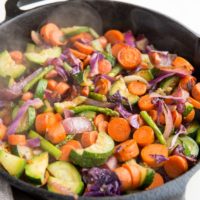
Easy Sautéed Vegetables Recipe
Ingredients
- 1 1/2 Tbsp avocado oil
- ½ small red onion sliced
- 4 very large carrots chopped
- 2 medium-sized zucchini squash chopped
- 1 bunch broccolini chopped (or 1 large crown broccoli)
- ½ bunch of asparagus trimmed and chopped
- 1 to 2 cups red cabbage thinly sliced
- ½ tsp sea salt to taste
Instructions
- Add the avocado oil to a large (10 to 12 inch) cast iron skillet and heat to medium-high. Allow the skillet to warm up completely before adding the hearty vegetables (if you’re following this exact recipe, that’s the carrots and the onion). Stir well until coated with oil, then cover the skillet and allow them to cook for a few minutes, until they begin to soften up.
- Add the less hearty vegetables (zucchini, broccoli, cabbage, asparagus) and stir well. Season the vegetables with sea salt and cover the skillet.
- Cook, stirring occasionally, until much liquid has seeped out of the vegetables and they have reached your desired level of done-ness, about 10 to 20 minutes total.
- If it appears at any point as though the vegetables are in a puddle of liquid, remove the lid and allow some liquid to burn off before covering again.
- If using cast iron, use a metal spatula to get underneath the vegetables so that they don’t break apart and also preserve the golden-brown sear they’ll eventually get.
- Allow the vegetables to sit for 2 minutes between stirring/flipping them to ensure they cook evenly.
- If at any point the vegetables become too dark or begin to burn, stir very well and lower the heat to medium for the remainder of the cooking process.
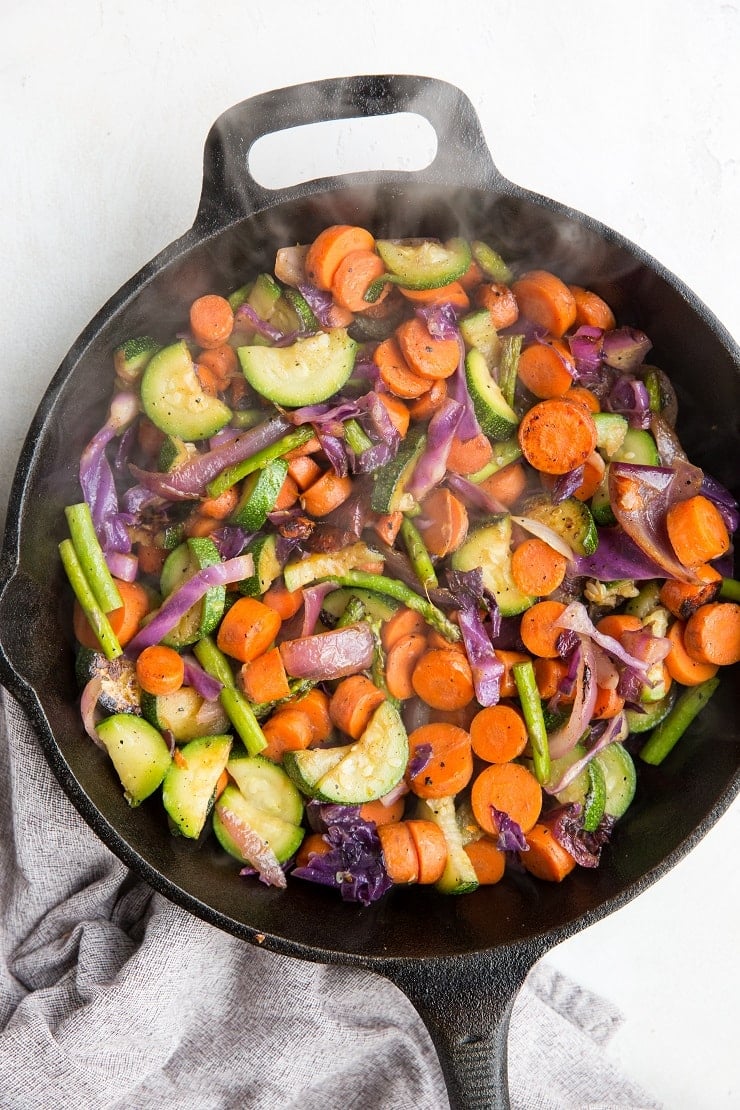
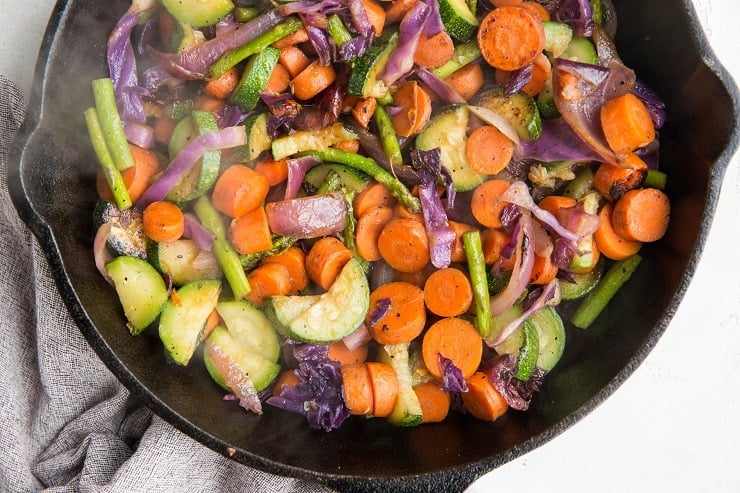
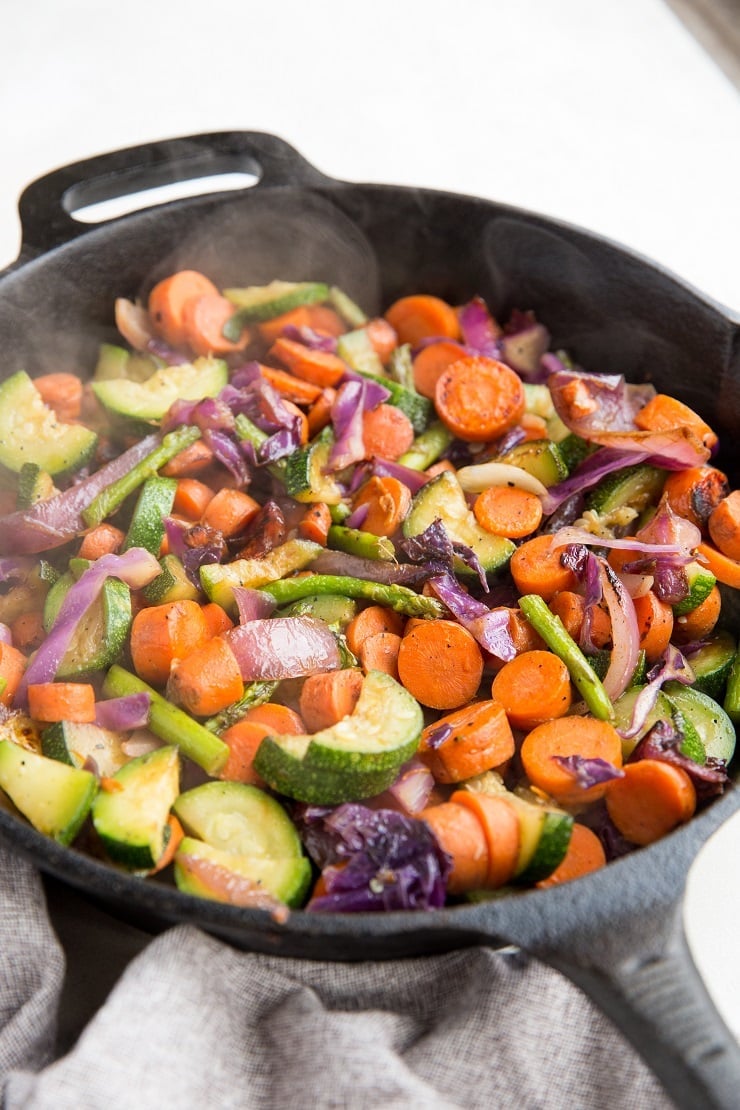
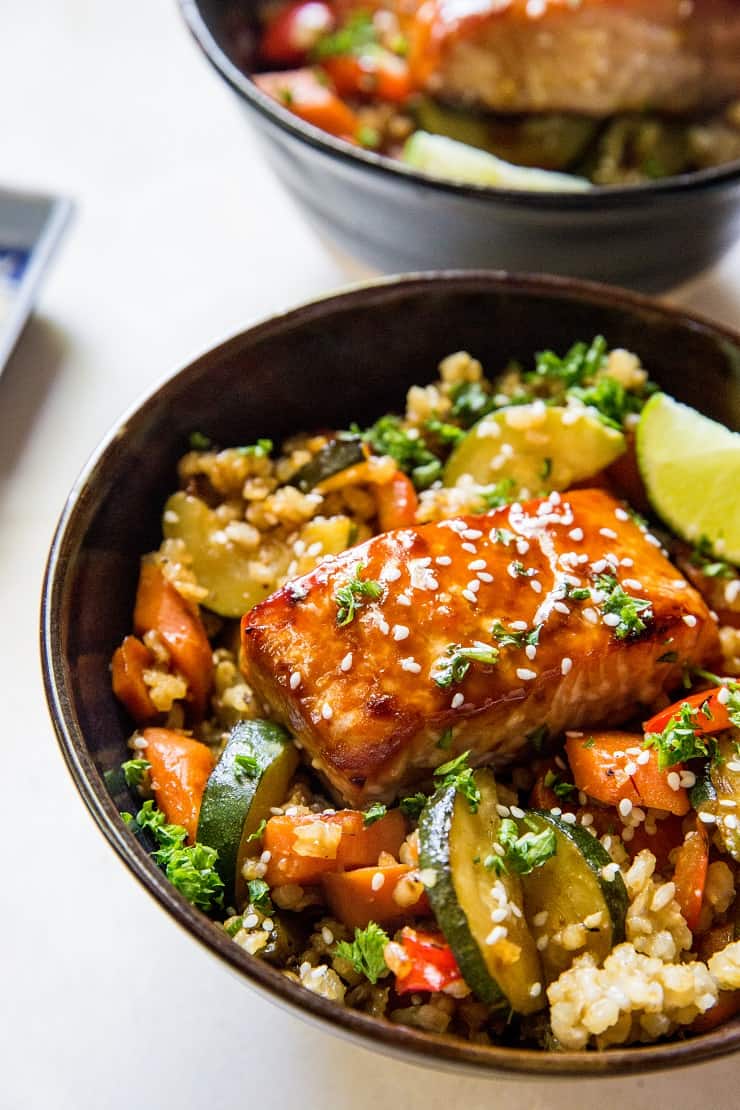
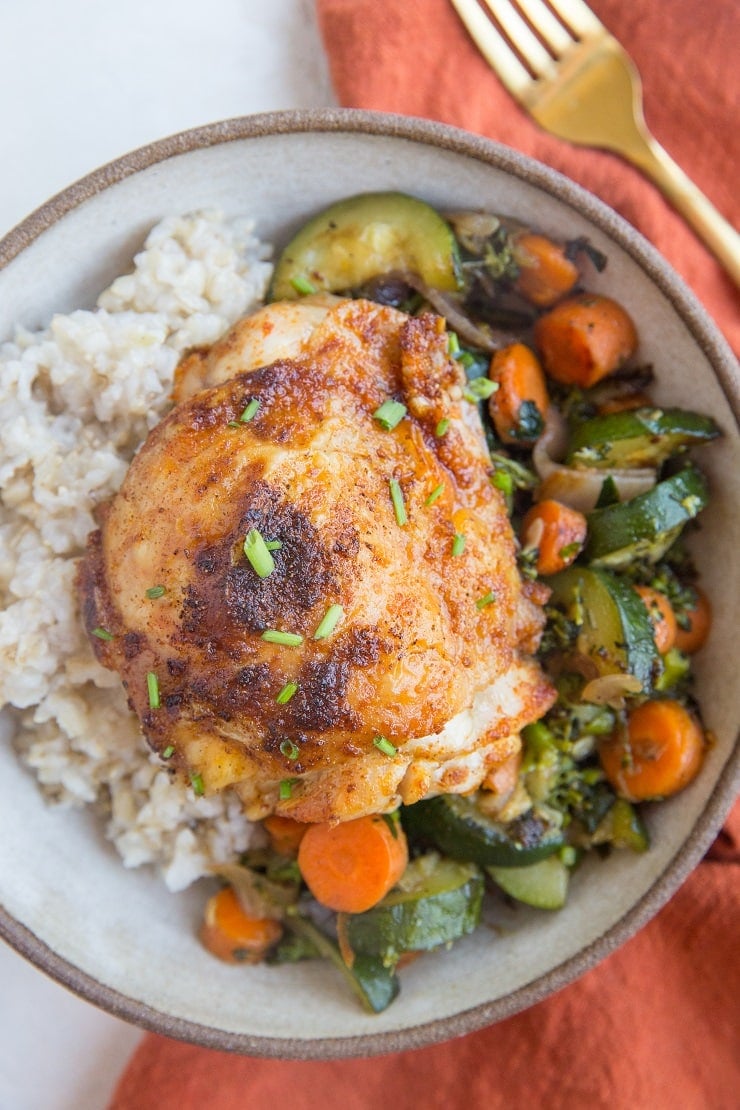
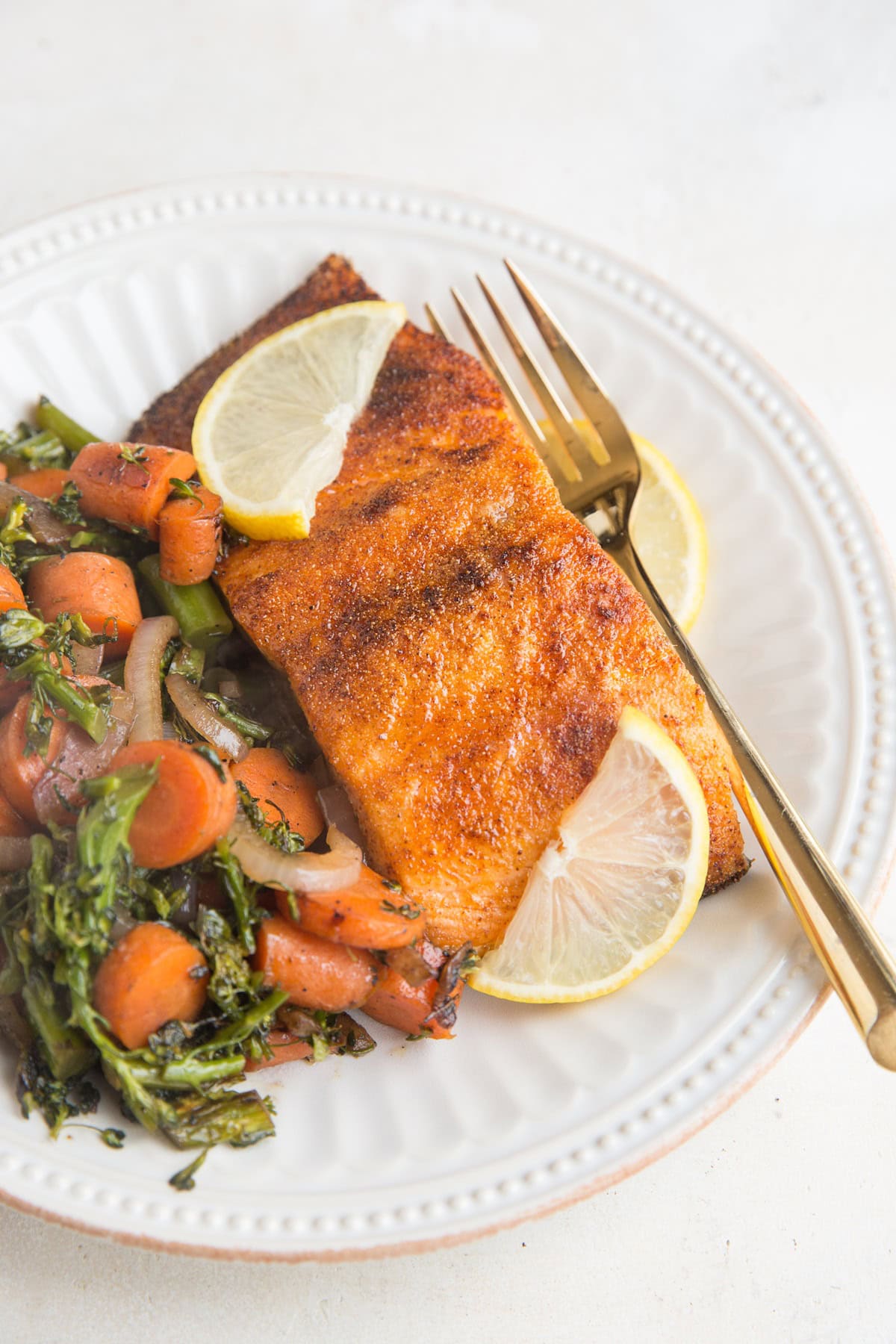
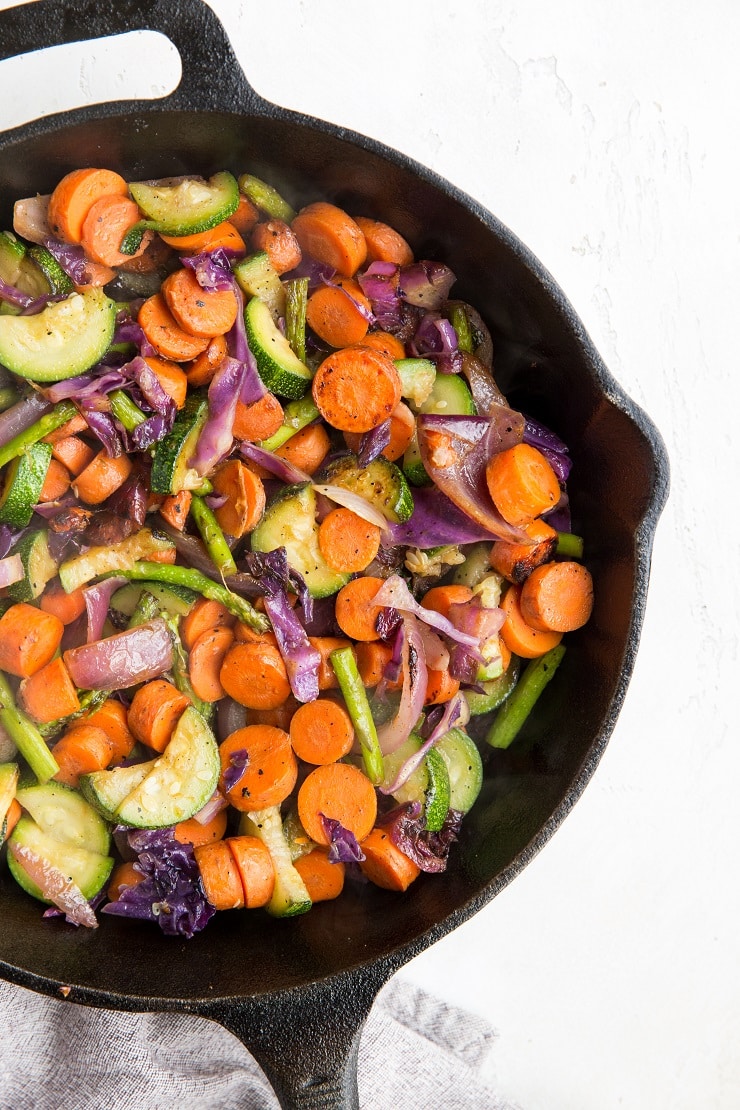
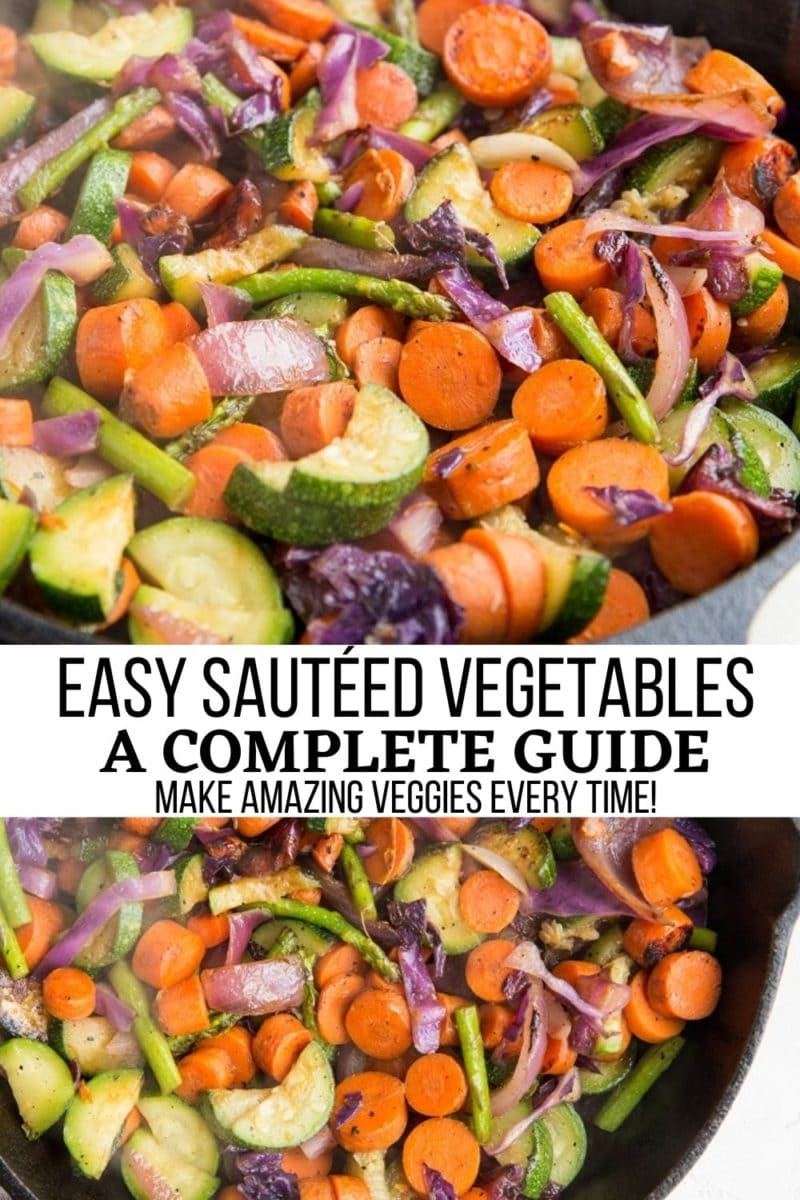

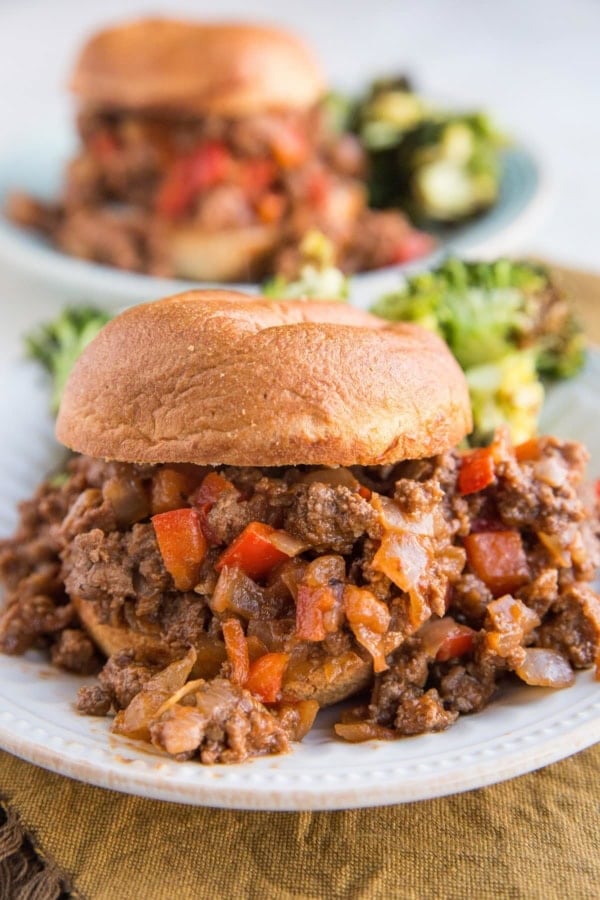
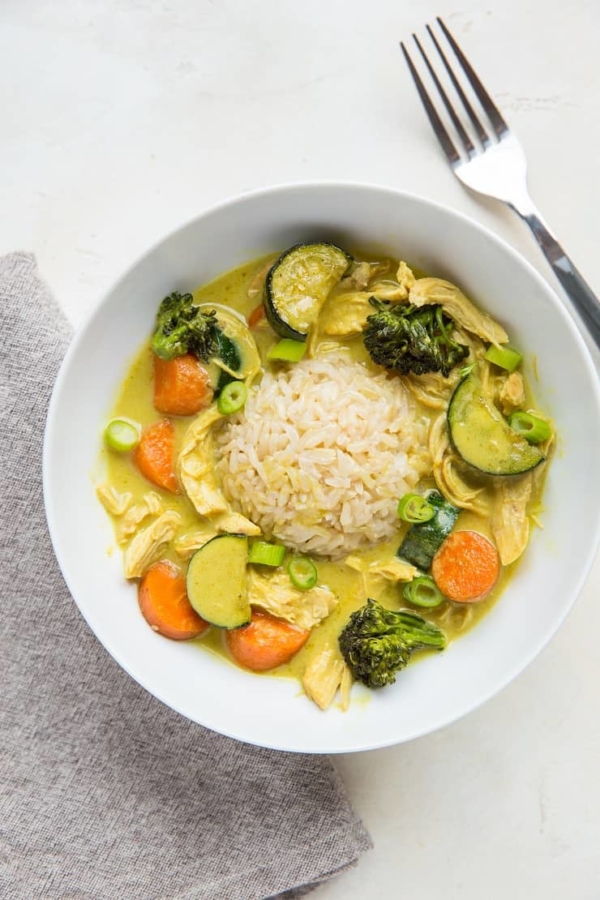
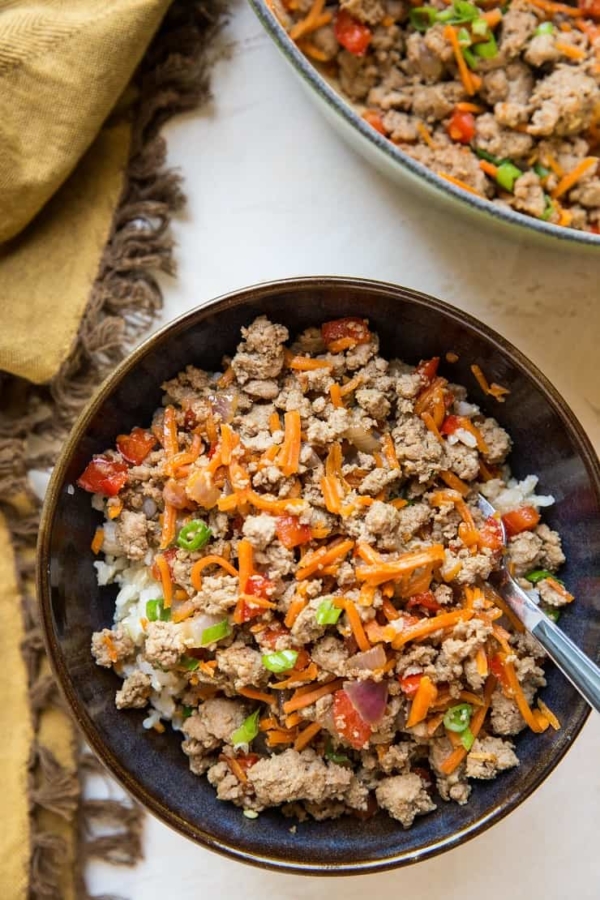
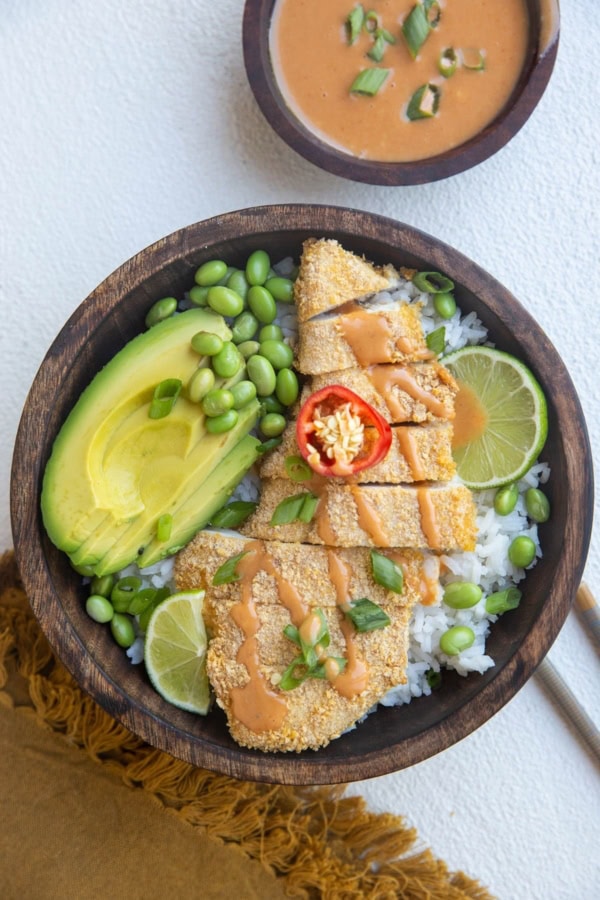









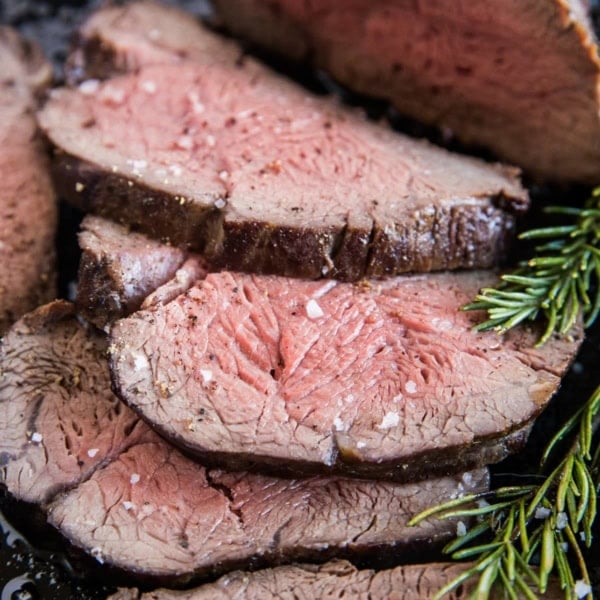
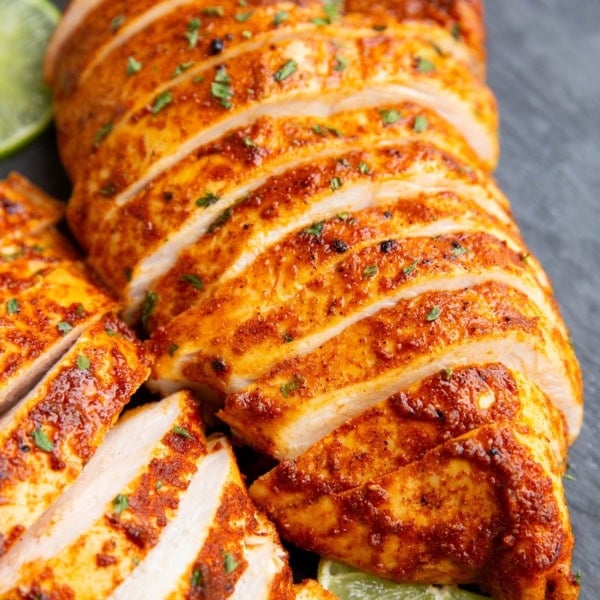
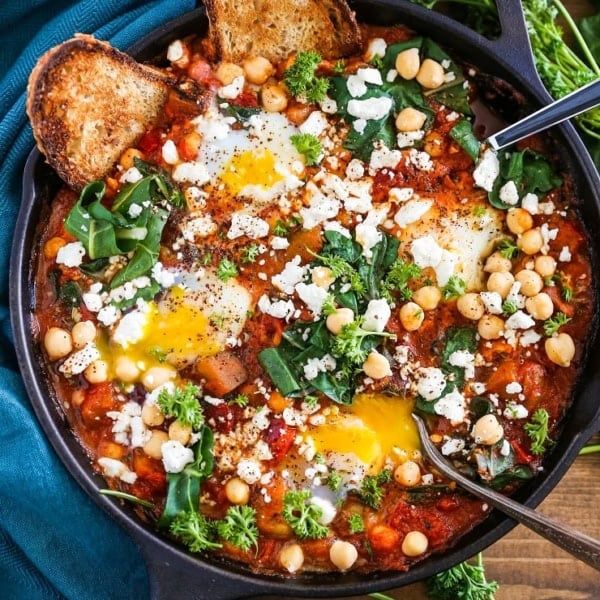
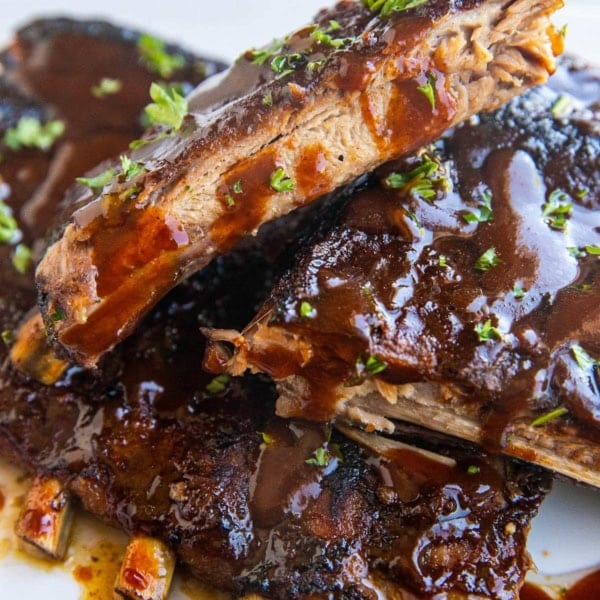
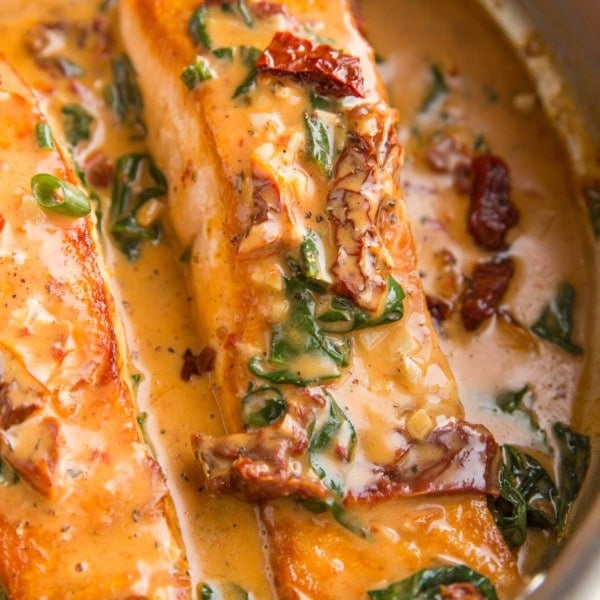
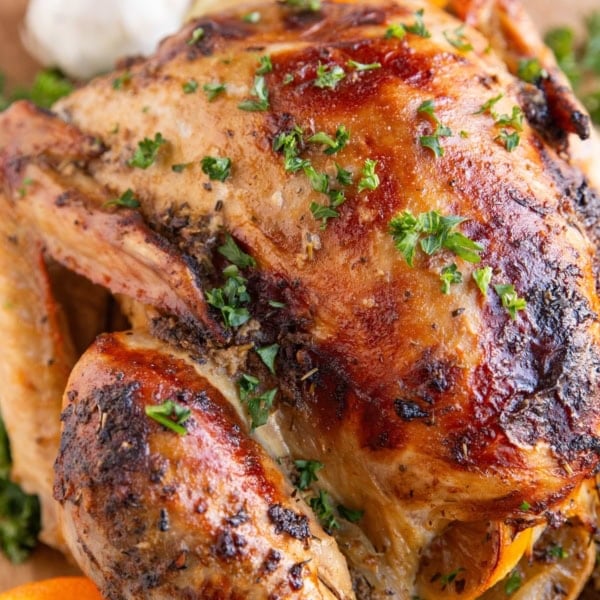
Is it just me or do other people find it absurd to assert that even a novice cook is unable to add vegetables to a dish according to how long they take to cook properly?
🧐
I’ve never even heard of only cooking vegetables together which are the same hardiness or cook times
🤷🏻
Sweet! Try sautéing sweet potato and zucchini together at the same time and let me know how it turns out.
wondering about how many cups of approximate cups of veggies before sautéed? Trying this with the Turkey Meatballs today!!
I’m so happy to hear that! For me, it typically ends up being around 6 cups of veggies. Hope you enjoy!